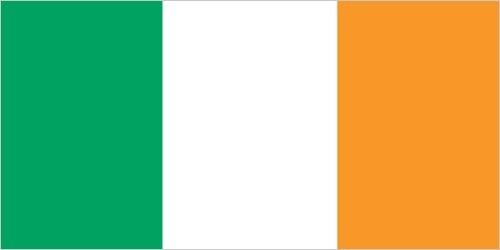84 Ireland

Three equal vertical bands of green (hoist side), white, and orange. Officially the flag colors have no meaning, but a common interpretation is that the green represents the Irish nationalist (Gaelic) tradition of Ireland. Orange represents the Orange tradition (minority supporters of William of Orange). White symbolizes peace (or a lasting truce) between the green and the orange.
Flag courtesy of the CIA World Factbook

Map courtesy of the CIA World Factbook

Blarney Castle, near Cork, was built in the 15th century and houses the famed Stone of Eloquence (the Blarney Stone). It has a huge square tower with a massive parapet, and a lookout tower. The castle was the stronghold of the McCarthys.
Photo courtesy of the CIA World Factbook
Government
According to Britannica, the Irish republic is a parliamentary democracy. Its constitution was promulgated in 1937 and can be amended through a referendum. The country’s head of state, the president (uachtarán), is elected directly by the public for a term of seven years and is eligible for reelection for a second term. The president normally acts on the advice of the government but also consults an advisory Council of State in the exercise of certain functions. The president signs and promulgates bills passed by the Oireachtas (Parliament) and, when so advised by the prime minister (taoiseach), summons and dissolves the Oireachtas. The president may, however, refuse to dissolve the Oireachtas on the advice of a prime minister who has ceased to command a majority in the Dáil Éireann (House of Representatives). The president is the guardian of the constitution and may, in certain circumstances, submit a bill passed by the Oireachtas to the people in a referendum or refer it to the Supreme Court to decide on its constitutionality.
There are two houses of the Oireachtas, the Dáil and the Seanad Éireann (Senate). Chief legislative power is centered in the 158-member Dáil. The Seanad may delay bills passed by the Dáil, or it may suggest changes in them, but it cannot indefinitely block their passage into law.
Executive power is vested in the prime minister, who heads the cabinet and presides over its meetings. The prime minister, the deputy prime minister (tánaiste), and the minister for finance must be members of the Dáil. The other government ministers must be members of either house, but no more than two may be senators.
The local government system comprises five county borough corporations, five borough corporations in the major cities, and 29 county councils, as well as numerous urban district councils and boards of town commissioners. Each of these is elected at regular intervals by universal adult suffrage. Of the 29 county councils, only 24 represent whole counties. For administrative purposes, the traditional County Tipperary is divided into a North Riding and a South Riding, each having a county council, and Dublin also is divided, among three county councils (Dún Laoghaire–Rathdown, Fingal, and South Dublin). County councils and county borough corporations are responsible for physical planning, roads, sewerage and water supplies, housing, public libraries, fire services, and courthouses. Local government authorities in the republic have no functions in relation to police or education.
Important policy decisions (e.g., on local taxes, borrowing, and the making of bylaws) are made by the elected councils. Administration, on the other hand, is the responsibility of the county (or city) manager, who usually consults with members of the council before discharging important executive functions. There is a city manager for each county borough council, and for each county council there is a county manager, who also acts as manager for the lesser local authorities within the county. Non county boroughs, urban districts, and towns have more limited duties, and, in regard to functions outside their scope, they form part of the administrative counties in which they are situated. The local government system is supervised by the national Department of the Environment.
Irish law is based on common law as modified by subsequent legislation and by the constitution. Judges are appointed by the president and normally serve for life or until retirement. They may be removed from office only in the case of incapacity or “stated misbehavior” and then only by resolution of both houses of the Oireachtas.
There are district courts and circuit courts as well as a High Court and a Supreme Court that acts as the court of final appeal. The Supreme Court consists of the chief justice and seven other judges. The circuit courts have jurisdiction to try all serious offenses except murder, treason, and piracy. Criminal trials, which take place before a jury, can be held in a circuit court or in the central criminal court (a division of the High Court). A special criminal court was established in 1972 with jurisdiction over cases of terrorism.
Irish Aviation Authority
The Irish Aviation Authority is responsible for the management of Irish controlled airspace, the safety regulation of Irish civil aviation and the oversight of civil aviation security in Ireland. The IAA has three main functions: the provision of air traffic management and related services in Irish controlled airspace, the safety regulation of the civil aviation industry in Ireland and the oversight of civil aviation security in Ireland.
Airspace
SkyVector – Google Maps – ADS-B Exchange
ICAO countries publish an Aeronautical Information Publication (AIP). This document is divided into three parts: General (GEN), En Route (ENR) and Aerodromes (AD). ENR 1.4 details the types of airspace classes they chose to adopt from classes A through G.
AirNav Ireland
AirNav Ireland provides air traffic management services including:
Air Traffic Control
Flight information Alerting
Search and rescue services
Aeronautical information
North Atlantic Communications
AirNav Ireland provides air traffic management services in the 451,000 km2 of airspace controlled by Ireland. This airspace forms a crucial gateway for air traffic between Europe and North America.
Drone Regulations
Counter-UAS (C-UAS) Laws
2023 – Dublin Airport Operator Acquires “Anti-Drone” Equipment
2023 – Dublin Airport Counter-Drone Systems Now Fully Operational
Advanced Air Mobility (AAM) Regulations & Policies
Bilateral agreements facilitate the reciprocal airworthiness certification of civil aeronautical products imported/exported between two signatory countries. A Bilateral Airworthiness Agreement (BAA) or Bilateral Aviation Safety Agreement (BASA) with Implementation Procedures for Airworthiness (IPA) provides for airworthiness technical cooperation between the FAA and its counterpart civil aviation authorities.
Reciprocal acceptance of aviation safety-related approvals and services with the European Union Aviation Safety Agency (EASA) and Member States of the European Union are primarily governed by the U.S. – European Union Safety Agreement.
Flight Standards Agreements
Article 83 bis Agreement
Article 83 bis agreement is an agreement between two Contracting States that have ratified Article 83 bis, in terms of which the State of Registry transfers all or some of its functions and duties to the State of the Operator.
Advanced Air Mobility (AAM) News
2025 – Can owners stop drone deliveries flying over their property?
2025 – Beta’s Alia CX300 Electric Aircraft Starts European Tour in Ireland
2025
Video courtesy of Advanced Air Mobility Institute from the January 2025 Global AAM Forum. Complete session for Day 1 of this Forum is available on the Advanced Air Mobility Institute YouTube Channel
2025 – Horizon examines hybrid eVTOL aircraft use for Irish air ambulances
2024 – Report Calls for Irish Advanced Air Mobility Network
2024 – Dublin City Council Launches Drone & UAM Strategy
2024 – Irish city council releases 5-year drone strategy
Short Essay Questions
Scenario-Based Question
You have been hired by a Drone Startup Company. Your boss has immediately assigned this job to you.
They need you to prepare a one-page memo detailing the legalities of using a drone to film Blarney Castle near Cork, pictured above.
They need you to mention any national laws and local ordinances.
They specifically want to know what airspace (insert pictures) you will be operating in and whether or not you need an airspace authorization.
Does it matter whether or not you are a citizen of the country?
Lastly, there is a bonus for you if, as you scroll through this chapter, you find any typos or broken links!
Short Essay Questions
- What are the drone categories?
- How is registration addressed?
- How is remote ID addressed?
- What are the model aircraft rules?
- What are the commercial drone rules?
- Are there waivers or exemptions to the rules? If so, for what?
- Would you share a link to an interactive airspace map?
- How is BVLOS addressed?
- How can you fly drones at night?
- How can you fly drones over people?
- Where do you find drone NOTAMs?
- What are the rules for drone maintenance?
- What are the rules for an SMS program?
- What are some unique rules not mentioned above?
- What are the C-UAS rules?
- What are the AAM rules?

